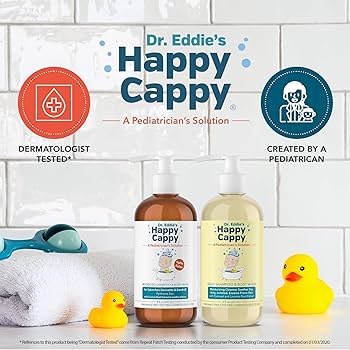Cradle cap is a common concern for many parents, especially when dealing with a newborn. If you’ve noticed those yellow, scaly patches on your baby’s scalp, you’re not alone! But don’t worry; cradle cap shampoos claim to help. The question is, do they really work, or is it just another marketing gimmick? Let’s dive deep into cradle cap shampoos and determine whether they are worth the hype.
What Is Cradle Cap?
Cradle cap, medically known as infantile seborrheic dermatitis, is a harmless but sometimes stubborn condition that affects babies, usually in the first three months. It appears as yellow or white crusty flakes on the scalp, sometimes spreading to the eyebrows and behind the ears.
What Causes Cradle Cap?
1. Excess Sebum Production
The primary culprit behind cradle cap is excessive oil production (sebum) by the baby’s sebaceous glands. This oil traps dead skin cells, leading to the flaky appearance.
2. Fungal or Bacterial Growth
Some studies suggest that Malassezia, a yeast-like fungus, may contribute to cradle cap by thriving in the excess oil on the baby’s scalp.
3. Hormonal Influence
Babies may inherit maternal hormones from their mother, leading to increased oil production that encourages the development of cradle cap.
4. Sensitivity to Products
Some babies have sensitive skin, and certain shampoos, lotions, or detergents may exacerbate the condition.
How Does Cradle Cap Shampoo Work?
Cradle cap shampoos are specially formulated to:
- Loosen flakes for easier removal
- Control excess oil production
- Reduce fungal or bacterial growth
- Soothe irritation and prevent inflammation
Key Ingredients in Cradle Cap Shampoo
When choosing a cradle cap shampoo, look for these effective and baby-safe ingredients:
1. Salicylic Acid
A mild exfoliant that helps shed dead skin cells gently.
2. Coconut Oil
Known for its moisturizing and antimicrobial properties, helping soften the crusty patches.
3. Tea Tree Oil
A natural antiseptic that fights fungal infections and soothes inflammation.
4. Aloe Vera
Offers hydration and cooling relief, perfect for calming irritated baby skin.
5. Colloidal Oatmeal
A gentle anti-inflammatory that reduces redness and itching.
Best Cradle Cap Shampoos on the Market
1. Mustela Foam Shampoo for Newborns
- Hypoallergenic and tear-free
- Contains avocado extract for hydration
- Free from parabens and phthalates
2. Cetaphil Baby Shampoo & Wash
- Gentle formula with organic calendula
- Dermatologist-tested for sensitive skin
- Mild fragrance for a fresh feel
3. FridaBaby DermaFrida Flake Fixer Shampoo
- Includes a sponge and scrubber for better flake removal
- Fragrance-free and dermatologist-tested
- Designed for cradle cap and general baby hair care
4. Burt’s Bees Baby Shampoo & Wash
- Infused with natural plant-based cleansers
- Sulfate-free for a gentle touch
- Contains buttermilk to nourish baby skin
How to Use Cradle Cap Shampoo Effectively
Follow these easy steps to get the best results:
1. Wet the Baby’s Scalp
Use lukewarm water to soften the flakes before applying shampoo.
2. Apply a Small Amount of Shampoo
Gently massage the shampoo into the scalp using your fingers or a soft brush.
3. Let It Sit for a Few Minutes
This allows the active ingredients to work on the flakes.
4. Rinse Thoroughly
Make sure no residue is left behind, as leftover product may worsen the condition.
5. Use a Soft Brush or Cloth
After rinsing, gently brush the scalp to remove loosened flakes.
Are Cradle Cap Shampoos Safe?
Most high-quality cradle cap shampoos are dermatologist-approved and safe for infants. However, always check the ingredients list and opt for fragrance-free, sulfate-free, and paraben-free formulas to minimize irritation.
Do Cradle Cap Shampoos Really Work?
Yes, but with consistent use! Cradle cap shampoos are not an instant cure, but they help control and gradually eliminate the flakes. You should see visible improvements within 1-2 weeks of regular use.
Can Cradle Cap Go Away on Its Own?
In most cases, yes! Cradle cap is usually harmless and will clear up within a few months. However, using a gentle shampoo can speed up the process and prevent discomfort.
Alternatives to Cradle Cap Shampoo
If you prefer natural remedies, try these:
- Coconut oil: Softens flakes for easy removal
- Olive oil: Moisturizes and soothes the scalp
- Petroleum jelly: Helps lift stubborn patches
- Apple cider vinegar (diluted): Balances scalp pH
When to See a Doctor
If your baby’s cradle cap:
- Spreads to other areas (face, diaper region, etc.)
- Becomes red, swollen, or oozing (signs of infection)
- Does not improve after weeks of care
It’s best to consult a pediatrician for a more targeted treatment plan.

Final Verdict: Is Cradle Cap Shampoo Legit or a Scam?
Cradle cap shampoos are legit and can help with managing and reducing cradle cap over time. While they won’t work overnight, they provide a safe and effective way to treat your baby’s scalp gently. Choosing the right shampoo with mild and effective ingredients is key!
FAQs
1. Can I use regular baby shampoo for cradle cap?
Regular baby shampoo may help, but specialized cradle cap shampoos contain active ingredients that target excess oil and flakes.
2. How often should I use cradle cap shampoo?
Most pediatricians recommend 2-3 times a week until the condition improves.
3. Can cradle cap come back after treatment?
Yes, but it usually resolves completely as your baby grows and their oil production stabilizes.
4. Is cradle cap contagious?
No, cradle cap is not contagious and is not caused by poor hygiene.
5. What’s the best home remedy for cradle cap?
Applying coconut oil before shampooing can help loosen flakes naturally.